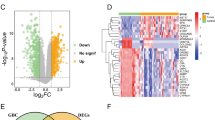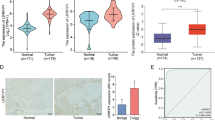Abstract
Objective The mammalian target of rapamycin (mTOR) pathway, an important regulator of multiple cellular functions including proliferation, differentiation, tumorigenesis, and apoptosis, is up-regulated in many cancers. It has achieved considerable importance. This study was conducted to determine the status of the mTOR pathway in human hepatocellular carcinoma (HCC) and to investigate its relationship with the prognosis of HCC. Methods PTEN, pAkt, p27, and pS6 expression in cryo-sections gathered from 528 cases with HCC by the method of immunohistochemistry. Kaplan–Meier survival and Cox regression analyses were performed to evaluate the prognosis of HCC. Results The mTOR pathway was more significantly altered in high-grade tumors, and tumors with poor prognostic features. Especially, pAkt and cytoplasmic p27 expression showed the strongest associations with pathological parameters of HCC. Statistical analysis showed that HCC patients expressing pAkt, PTEN, cytoplasmic p27, and pS6 have different overall survival rates relative to those not expressing these proteins. Cox multi-factor analysis showed that tumor differentiation (P = 0.006), vascular invasion (P = 0.028), TNM stage (P = 0.005), pAkt (P = 0.021), PTEN (P = 0.003), p27 (P = 0.018) and pS6 (P = 0.002) were independent prognosis factors for HCC. Conclusion: Expression of the mTOR pathway components, which are related with the transferability and invasive capacity of HCC cells, may be used as prognostic indicators in HCC.



Similar content being viewed by others
Abbreviations
- mTOR:
-
Mammalian target of rapamycin
- HCC:
-
Hepatocellular carcinoma
References
Farazi PA, DePinho RA. Hepatocellular carcinoma pathogenesis: from genes to environment. Nat Rev Cancer. 2006;6:674–87. doi:10.1038/nrc1934.
Thorgeirsson SS, Grisham JW. Molecular pathogenesis of human hepatocellular carcinoma. Nat Genet. 2002;31:339–46. doi:10.1038/ng0802-339.
Baylin SB, Ohm JE. Epigenetic gene silencing in cancer—a mechanism for early oncogenic pathway addiction? Nat Rev Cancer. 2006;6:107–16. doi:10.1038/nrc1799.
Inoki K, Corradetti MN, Guan KL. Dysregulation of the TSC-mTOR pathway in human disease. Nat Genet. 2005;37:19–24. doi:10.1038/ng1494.
Guertin DA, Sabatini DM. An expanding role for mTOR in cancer. Trends Mol Med. 2005;11:353–61. doi:10.1016/j.molmed.2005.06.007.
Hardie DG. The AMP-activated protein kinase pathway new players upstream and downstream. J Cell Sci. 2004;117:5479–87. doi:10.1242/jcs.01540.
Martin DE, Hall MN. The expanding TOR signaling network. Curr Opin Cell Biol. 2005;17:158–66. doi:10.1016/j.ceb.2005.02.008.
Law BK. Rapamycin: an anti-cancer immunosuppressant? Crit Rev Oncol Hematol. 2005;56:47–60. doi:10.1016/j.critrevonc.2004.09.009.
Shaw RJ, Bardeesy N, Manning BD. The LKB1 tumor suppressor negatively regulates mTOR signaling. Cancer Cell. 2004;6(1):91–9. doi:10.1016/j.ccr.2004.06.007.
Chan S. Targeting the mTOR: a new approach to treating cancer. Br J Cancer. 2004;91:1420–4. doi:10.1038/sj.bjc.6602162.
Ishak KG, Anthony PP, Sobin LH. Nonepithelial tumors. In: Ishak KG, editor. Histological typing of tumors of the liver. World Health Organization International Classification of Tumors. Berlin: Springer; 1994. pp. 22–7.
Wittekind C. Pitfalls in the classification of liver tumors. Pathologe. 2006;27:289–93. doi:10.1007/s00292-006-0834-1.
Gao Q, Qiu SJ, Fan J, Zhou J, Wang XY, Xiao YS. Intratumoral balance of regulatory and cytotoxic T cells is associated with prognosis of hepatocellular carcinoma after resection. J Clin Oncol. 2007;25:2586–93. doi:10.1200/JCO.2006.09.4565.
Zhu XD, Zhang JB, Zhuang PY, Zhu HG, Zhang W, Xiong YQ. High expression of macrophage colony-stimulating factor in peritumoral liver tissue is associated with poor survival after curative resection of hepatocellular carcinoma. J Clin Oncol. 2008;26:2707–16. doi:10.1200/JCO.2007.15.6521.
Pantuck AJ, Seligson DB, Klatte T. Prognostic relevance of the mTOR pathway in renal cell carcinoma. Cancer. 2007;109:2257–67. doi:10.1002/cncr.22677.
El-Serag HB, Rudolph KL. Hepatocellular carcinoma: epidemiology and molecular carcinogenesis. Gastroenterology. 2007;132:2557–76. doi:10.1053/j.gastro.2007.04.061.
Blum H. Hepatocellular carcinoma: therapy and prevention. World J Gastroenterol. 2005;11:7391–400.
Donato F, Tagger A, Gelatti U, Parrinello G, Boffetta P, Albertini A. Alcohol and hepatocellular carcinoma: the effect of lifetime intake and hepatitis virus infections in men and women. Am J Epidemiol. 2002;155:323–33. doi:10.1093/aje/155.4.323.
Hashimoto E, Taniai M, Kaneda H, Tokushige K, Hasegawa K, Okuda H. Comparison of hepatocellular carcinoma patients with alcoholic liver disease and nonalcoholic steatohepatitis. Alcohol Clin Exp Res. 2004;28:164S–8S.
Kurozawa Y, Ogimoto I, Shibata A, Nose T, Yoshimura T, Suzuki H. JACC Study Group. Coffee and risk of death from hepatocellular carcinoma in a large cohort study in Japan. Br J Cancer. 2005;93:607–10. doi:10.1038/sj.bjc.6602737.
Maheshwari S, Sarraj A, Kramer J, El-Serag HB. Oral contraception and the risk of hepatocellular carcinoma. J Hepatol. 2007;47:506–13. doi:10.1016/j.jhep.2007.03.015.
Aravalli RN, Steer CJ, Cressman ENK. Molecular mechanisms of hepatocellular carcinoma. Hepatology. 2008; 2047–63.
Zhou X, Tan M, Stone Hawthorne V. Activation of the Akt/mammalian target of rapamycin/4E-BP1 pathway by ErbB2 over expression predicts tumor progression in breast cancers. Clin Cancer Res. 2004;10:6779–88. doi:10.1158/1078-0432.CCR-04-0112.
Luo J, Manning BD, Cantley LC. Targeting the PI3 K-Akt pathway in human cancer: rationale and promise. Cancer Cell. 2003;4:257–62. doi:10.1016/S1535-6108(03)00248-4.
Bjornsti MA, Houghton PJ. The TOR pathway: a target for cancer therapy. Nat Rev Cancer. 2004;4:335–48. doi:10.1038/nrc1362.
Pene F, Claessens Y-E, Muller O. Role of the phosphatidylinositol 3-kinase/Akt and mTOR/P70S6-kinase pathways in the proliferation and apoptosis in multiple myeloma. Oncogene. 2002;21:6587–97. doi:10.1038/sj.onc.1205923.
Hay N, Sonenberg N. Upstream and downstream of mTOR. Genes Dev. 2004;18:1926–45. doi:10.1101/gad.1212704.
Neshat MS, Mellinghoff IK, Tran C. Enhanced sensitivity of PTEN-deficient tumors to inhibition of FRAP/mTOR. Proc Natl Acad Sci USA. 2001;98:10314–9. doi:10.1073/pnas.171076798.
Wu FY, Wang SE, Sanders ME. Reduction of cytosolic p27(Kip1) inhibits cancer cell motility, survival, and tumorigenicity. Cancer Res. 2006;66:2162–72. doi:10.1158/0008-5472.CAN-05-3304.
Viglietto G, Motti ML, Bruni P. Cytoplasmic relocalization and inhibition of the cyclin-dependent kinase inhibitor p27(Kip1) by PKB/Akt-mediated phosphorylation in breast cancer. Nat Med. 2002;8:1136–44. doi:10.1038/nm762.
Author information
Authors and Affiliations
Corresponding author
Rights and permissions
About this article
Cite this article
Zhou, L., Huang, Y., Li, J. et al. The mTOR pathway is associated with the poor prognosis of human hepatocellular carcinoma. Med Oncol 27, 255–261 (2010). https://doi.org/10.1007/s12032-009-9201-4
Received:
Accepted:
Published:
Issue Date:
DOI: https://doi.org/10.1007/s12032-009-9201-4




